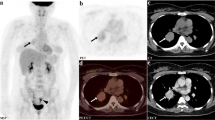Abstract
Purpose
To evaluate the role of FDG-PET/CT scanning in the management of HIV-associated multicentric Castleman’s disease (MCD) a rare lymphoproliferative disorder associated with infection by human herpesvirus 8 (HHV8).
Materials and methods
Nine patients with histologically confirmed MCD underwent fused FDG-PET/CT scans at initial MCD diagnosis (n = 3), at MCD relapse (n = 4), or during remission (n = 2). All seven patients with active MCD had markedly elevated plasma HHV8 viral loads, but the patients in remission had no HHV8 viraemia. The three patients with newly diagnosed MCD were not on antiretroviral therapy at the time of imaging, but the other six were all on fully suppressive antiretroviral regimens.
Results
In the seven patients with active MCD (newly diagnosed or relapse) 33/91 lymph node groups (36%) included radiologically enlarged nodes on the CT scan, whilst 57/91 lymph node groups (63%) showed enhanced FDG uptake on the PET scan. In scans from patients in remission, there were no enlarged lymph nodes on the CT scan but 3 lymph nodes (11%) demonstrated enhanced FDG uptake. The median SUV recorded for the seven patients with active MCD was 4.8 (range 2.6–9.3) which was significantly higher than the median value of 2.5 recorded for the patients in remission (Mann-Whitney U test, p = 0.011).
Conclusion
Despite the small number of patients, in HIV-positive individuals with active MCD, FDG-PET scans more frequently detected abnormal uptake than CT scans detected enlarged lymph nodes. FDG-PET scanning has a useful role in the management of HIV-associated MCD in selecting appropriate sites for biopsy, and in staging and monitoring these lymphoproliferations.


Similar content being viewed by others
References
Stebbing J, Pantanowitz L, Dayyani F, Sullivan RJ, Bower M, Dezube BJ. HIV-associated multicentric Castleman’s disease. Am J Hematol 2008;83:498–503.
Bower M, Powles T, Williams S, Davis TN, Atkins M, Montoto S, et al. Brief communication: rituximab in HIV-associated multicentric Castleman disease. Ann Intern Med 2007;147:836–9.
Kojima M, Nakamura S, Shimizu K, Suda Y, Kasuga Y, Sugihara S, et al. Nodal marginal zone B-cell lymphoma resembling plasmacytoma arising from a plasma cell variant of localized Castleman’s disease: a case report. APMIS 2002;110:523–7.
Venizelos I, Tamiolakis D, Simopoulos C, Nikolaidou S, Barbagadaki S, Lambropoulou M, et al. Diffuse large B-cell lymphoma arising from a multicentric mixed variant of Castleman’s disease. Indian J Cancer 2004;41:135–7.
Chan JK, Tsang WY, Ng CS. Follicular dendritic cell tumor and vascular neoplasm complicating hyaline-vascular Castleman’s disease. Am J Surg Pathol 1994;18:517–25.
Zarate-Osorno A, Medeiros LJ, Danon AD, Neiman RS. Hodgkin’s disease with coexistent Castleman-like histologic features. A report of three cases. Arch Pathol Lab Med 1994;118:270–4.
Chim CS, Choi FP, Ooi GC, Kwong YL. Absence of gallium uptake in multicentric Castleman’s disease of plasma cell type. Haematologica 2001;86:442–3.
Murphy SP, Nathan MA, Karwal MW. FDG-PET appearance of pelvic Castleman’s disease. J Nucl Med 1997;38:1211–2.
Kunishima S, Taniguchi H, Koh T, Yamaguchi A, Yamagishi H. F-18 fluorodeoxyglucose positron emission tomography in mesenterial Castleman’s lymphoma. Clin Nucl Med 2001;26:789–90.
Blockmans D, Maes A, Stroobants S, Bobbaers H, Mortelmans L. FDG positron emission tomographic scintigraphy can reveal Castleman’s disease as a cause of inflammation. Clin Nucl Med 2001;26:975–6.
Reddy MP, Graham MM. FDG positron emission tomographic imaging of thoracic Castleman’s disease. Clin Nucl Med 2003;28:325–6.
Enomoto K, Nakamichi I, Hamada K, Inoue A, Higuchi I, Sekimoto M, et al. Unicentric and multicentric Castleman’s disease. Br J Radiol 2007;80:e24–66.
Hillier JC, Shaw P, Miller RF, Cartledge JD, Nelson M, Bower M, et al. Imaging features of multicentric Castleman’s disease in HIV infection. Clin Radiol 2004;59:596–601.
Mikhaeel NG, Hutchings M, Fields PA, O’Doherty MJ, Timothy AR. FDG-PET after two to three cycles of chemotherapy predicts progression-free and overall survival in high-grade non-Hodgkin lymphoma. Ann Oncol 2005;16:1514–23.
Hutchings M, Loft A, Hansen M, Pedersen LM, Buhl T, Jurlander J, et al. FDG-PET after two cycles of chemotherapy predicts treatment failure and progression-free survival in Hodgkin lymphoma. Blood 2006;107:52–9.
O’Doherty MJ, Barrington SF, Campbell M, Lowe J, Bradbeer CS. PET scanning and the human immunodeficiency virus-positive patient. J Nucl Med 1997;38:1575–83.
Dieval C, Bonnet F, Mauclere S, Masquelier B, Bentaberry F, Cazeau A, et al. Multicentric Castleman disease: use of HHV8 viral load monitoring and positron emission tomography during follow-up. Leuk Lymphoma 2007;48:1881–3.
Brust D, Polis M, Davey R, Hahn B, Bacharach S, Whatley M, et al. Fluorodeoxyglucose imaging in healthy subjects with HIV infection: impact of disease stage and therapy on pattern of nodal activation. AIDS 2006;20:985–93.
Author information
Authors and Affiliations
Corresponding author
Rights and permissions
About this article
Cite this article
Barker, R., Kazmi, F., Stebbing, J. et al. FDG-PET/CT imaging in the management of HIV-associated multicentric Castleman’s disease. Eur J Nucl Med Mol Imaging 36, 648–652 (2009). https://doi.org/10.1007/s00259-008-0998-4
Received:
Accepted:
Published:
Issue Date:
DOI: https://doi.org/10.1007/s00259-008-0998-4




